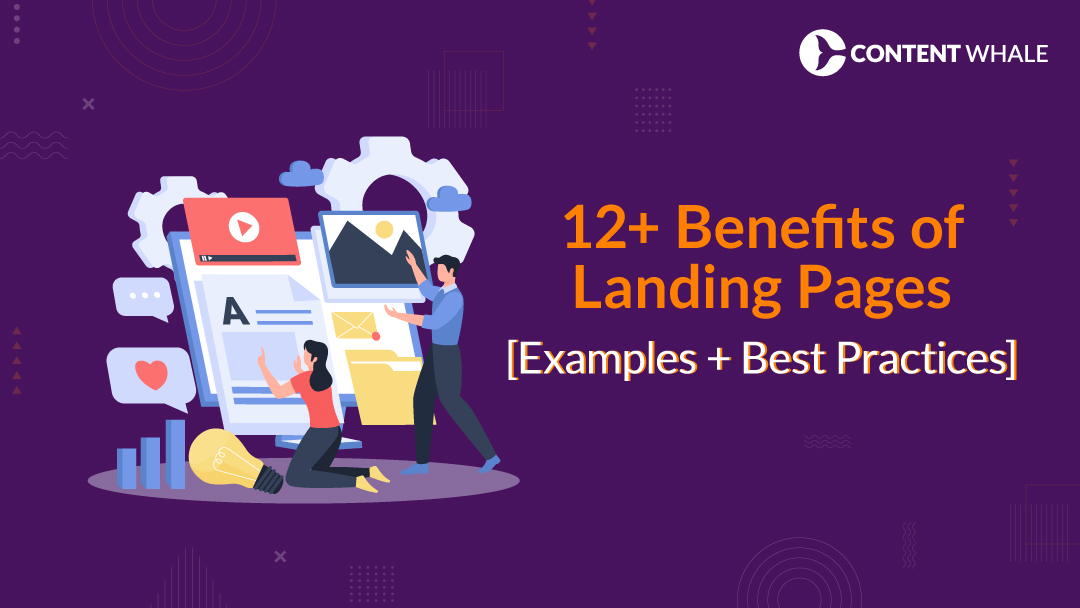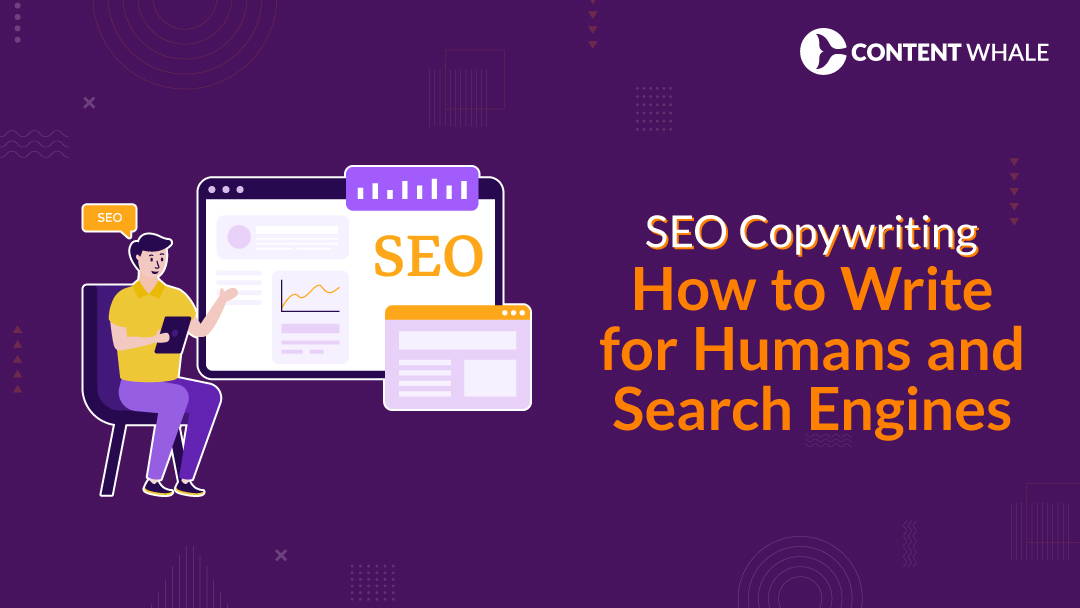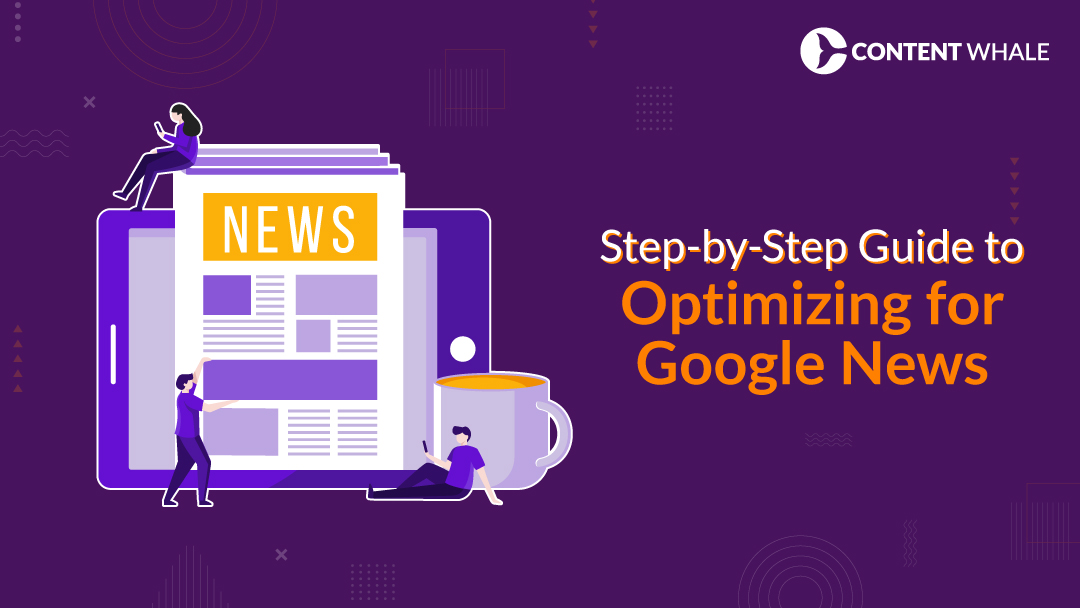Understanding the benefits of landing pages is crucial for enhancing digital marketing strategies and achieving high conversion rates. Landing pages, distinct from general webpages, are specifically designed with a single focus in mind, aimed at guiding visitors towards a specific action.
This blog explores the transformative advantages of landing pages across various industries, demonstrating through examples and best practices how these dedicated pages streamline the user experience and maximize marketing efforts. Here’s the basic overview of all the benefits of landing pages:
| Sr. No. | Benefit | Description |
|---|---|---|
| 1 | Enhanced Lead Generation | Landing pages are optimized to capture leads through targeted incentives like downloadable content, exclusive offers, or free trials. |
| 2 | Higher Conversion Rates | They focus content to guide visitors towards a specific action, dramatically increasing conversion rates. |
| 3 | Improved Brand Awareness | Landing pages use consistent branding and messaging to enhance brand recognition and identity. |
| 4 | Streamlined User Experience | They present clear, concise, and relevant content that simplifies the decision-making process for users. |
| 5 | Effective Data Collection | Landing pages allow marketers to gather specific data on user interactions and conversions, providing valuable insights for optimization. |
| 6 | Cost-Effective Marketing | They enable targeted marketing campaigns without extensive resources, offering a cost-effective solution. |
| 7 | Targeted Advertising Support | Landing pages align closely with ad copy, enhancing the effectiveness of paid advertising campaigns and improving ROI. |
| 8 | Enhanced Credibility and Trust | The inclusion of testimonials, endorsements, and security badges on landing pages builds trust and credibility. |
| 9 | Optimized for Search Engines | Landing pages can be optimized for SEO, improving search engine ranking and attracting more organic traffic. |
| 10 | Facilitates A/B Testing | They provide an ideal environment for A/B testing, allowing marketers to test different elements and optimize their strategies. |
| 11 | Supports Multiple Campaigns | Each page can be tailored for various marketing campaigns, addressing different audience segments with specific messaging and offers. |
| 12 | Immediate Feedback on Campaign Performance | They provide immediate data on how well a campaign is performing, allowing for quick adjustments to enhance effectiveness. |
Whether it’s increasing sales, generating leads, or bolstering brand awareness, embracing the benefits of having a landing page can significantly elevate your business’s online presence and effectiveness.
What is a Landing Page?
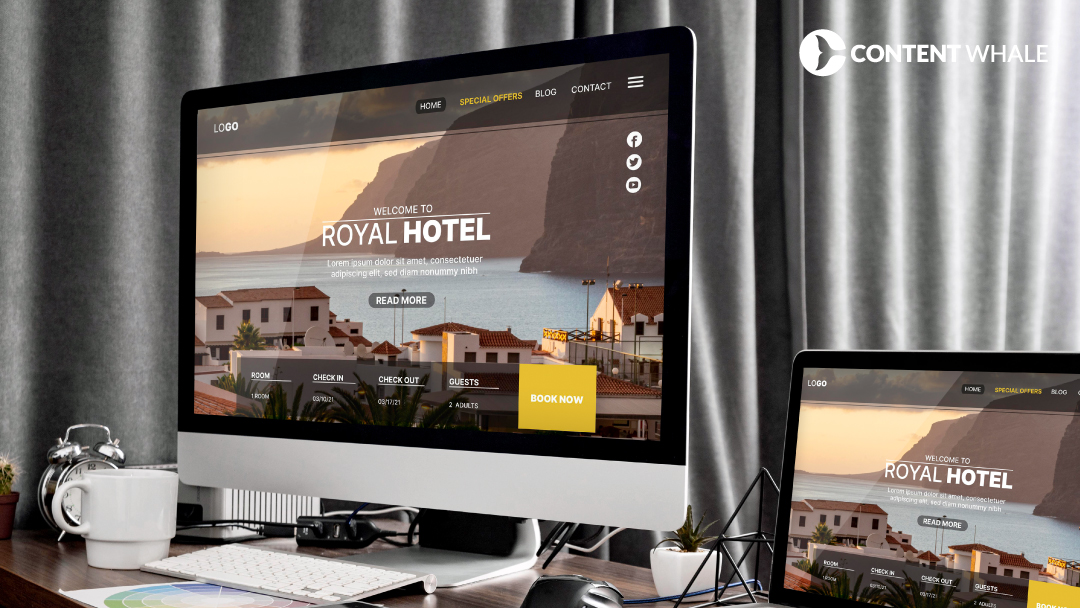
A landing page is a dedicated web page designed to receive and convert traffic from a specific marketing campaign. Unlike general websites, which often serve multiple purposes and encourage exploration, landing pages focus visitors on one specific action, making the decision-making process straightforward and direct. This specialization is key to their effectiveness and underlies many of the benefits of landing pages.
1. Focused on Conversion
The primary goal of a landing page is to convert visitors into leads or customers. By providing a clear, compelling call-to-action (CTA), landing pages reduce distractions and guide visitors toward completing a specific task, such as filling out a contact form or purchasing a product. This focus on a single goal is a significant advantage, as it increases the likelihood of conversion by minimizing options and simplifying the user’s decision-making process.
2. Tailored to Specific Audiences
Each landing page can be customized to target a particular audience segment, enhancing relevance and engagement. This customization might involve tweaking the message, design, or offers to better align with the interests or needs of incoming visitors. The ability to tailor content specifically for different segments maximizes the advantages of landing pages, making them more effective at capturing and retaining visitor interest.
3. Streamlining Campaigns
Landing pages are essential tools for streamlining marketing campaigns. They provide a precise match between the advertisement a visitor clicked on and the webpage they land on, which enhances the cohesion and relevance of the marketing message. This alignment not only improves user experience but also boosts the effectiveness of digital marketing campaigns by ensuring consistency across all touchpoints.
4. Enhancing Data Collection
With the focused nature of landing pages, marketers can collect specific data about how visitors interact with the page. This information is crucial for optimizing marketing strategies and better understanding what resonates with audiences. Efficient data collection and analysis are core advantages of having a landing page, allowing for more informed decisions that can lead to improved campaign outcomes.
In conclusion, landing pages are powerful tools in digital marketing arsenals, offering targeted engagement and efficient conversions. The benefits of landing pages stem from their ability to provide a direct, relevant, and compelling pathway for users to follow, which significantly enhances the effectiveness of online marketing efforts.
Why Use Landing Pages? The Power They Hold
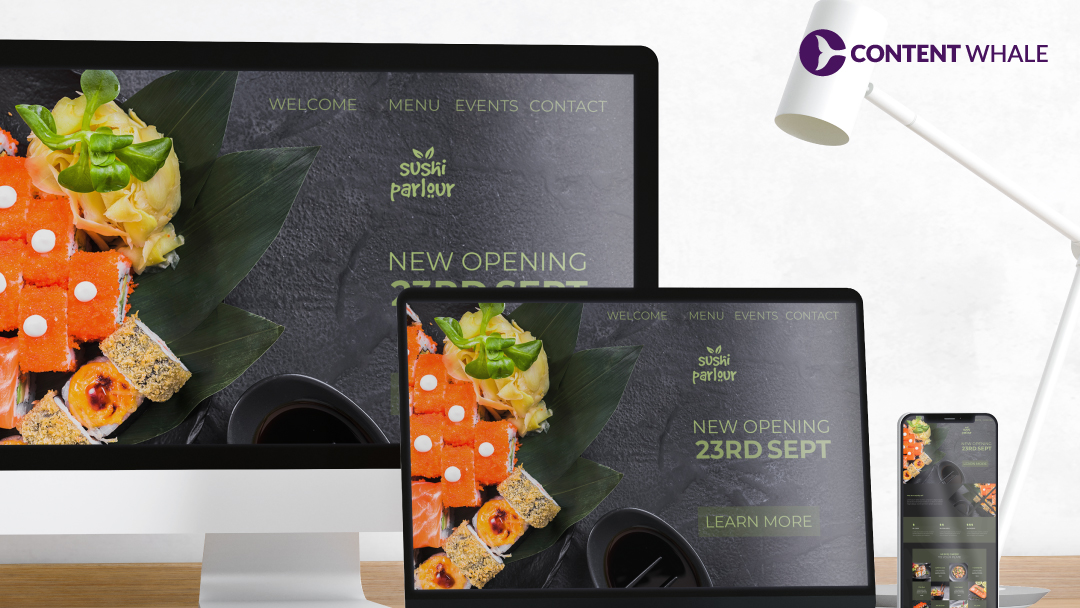
Landing pages are a pivotal element in digital marketing, designed specifically to enhance the effectiveness of promotional campaigns by focusing solely on a single call-to-action (CTA). This focus is instrumental in achieving higher conversion rates, which is a significant benefit of landing pages. By directing visitors to a landing page that matches the advertising content they clicked on, businesses ensure a consistent message, which greatly reduces visitor confusion and increases the likelihood of achieving the desired action.
1. Addressing User Intent
When users click on an ad, they have a specific intent or need in mind. Landing pages cater directly to this intent by providing visitors with exactly what they expect to see. This relevance is crucial because it aligns with the user’s initial interest, increasing the chances of conversion. The advantages of landing pages in addressing user intent lie in their ability to present a clear and concise message that is directly related to the user’s expectations, which optimizes the user’s journey from ad to action.
2. Streamlining the Conversion Funnel
A well-optimized landing page streamlines the conversion process by minimizing distractions and honing in on the key message and CTA. This setup is ideal for guiding visitors toward making a quick and decisive action, effectively moving them through the conversion funnel. This strategic funnel management is among the critical advantages of having a landing page, as it simplifies the user’s path to conversion, making it smoother and more compelling.
3. Enhancing Campaign Metrics
One of the principal advantages of landing pages is their capacity to improve campaign metrics such as click-through rates and conversion rates. Because landing pages are tailored to specific campaigns, they are more effective at engaging targeted audiences, resulting in better performance metrics. Moreover, the data collected from landing page interactions provides valuable insights that can be used to further refine and optimize marketing strategies, leading to continuously improved outcomes.
In summary, the benefits of landing pages include a more focused marketing message, a streamlined conversion process, and improved campaign effectiveness. Each of these elements plays a vital role in maximizing the impact of digital marketing efforts, making landing pages an indispensable tool for marketers aiming to drive specific actions and achieve significant results.
Unveiling the 12+ Powerful Benefits of Landing Pages
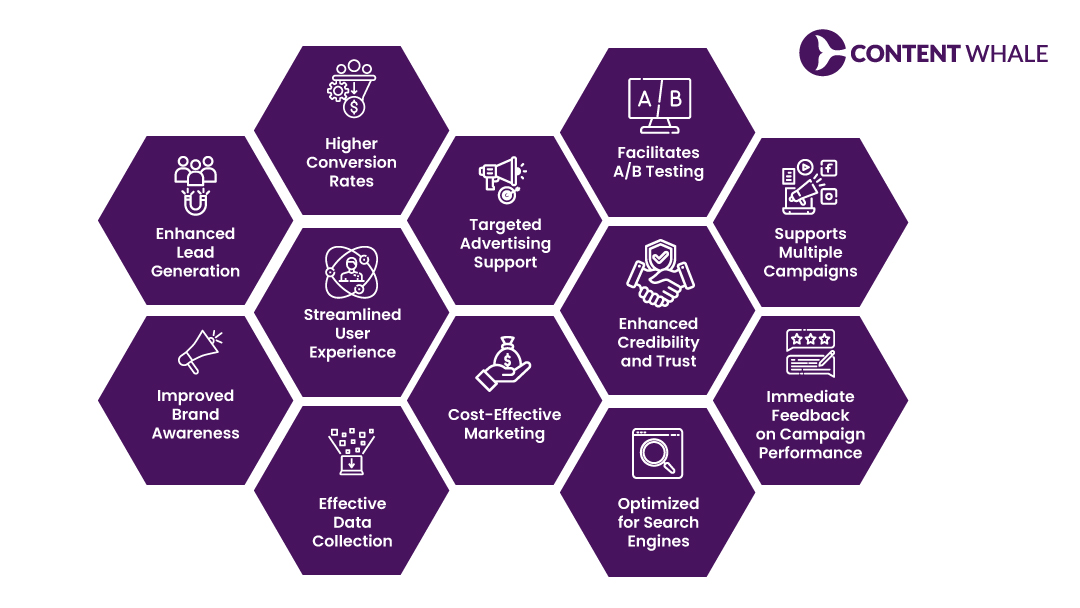
Landing pages are instrumental in digital marketing, providing specific advantages that enhance campaign effectiveness and efficiency. Here we break down twelve significant benefits, each supported by best practices and industry insights.
1. Enhanced Lead Generation
Landing pages are designed to capture leads efficiently. By offering targeted incentives like downloadable content, exclusive offers, or free trials, these pages encourage visitors to exchange their contact information for value. This setup is crucial for building a robust database of potential customers.
2. Higher Conversion Rates
Focused content on landing pages dramatically increases conversion rates. Without the distractions of a standard website, landing pages guide visitors directly toward completing a specific action, such as making a purchase or signing up for a newsletter.
3. Improved Brand Awareness
Landing pages amplify brand awareness by using consistent branding elements and messaging that resonate with the target audience. This targeted approach helps in establishing a strong, memorable brand identity.
4. Streamlined User Experience
A well-designed landing page simplifies the user experience. By presenting clear, concise, and relevant content, landing pages facilitate quick decision-making, enhancing overall user satisfaction and interaction.
5. Effective Data Collection
The ability to gather specific data is a key benefit of landing pages. Marketers can track how users interact with the page, which elements they engage with, and what ultimately drives them to convert, providing valuable insights for optimization.
6. Cost-Effective Marketing
Landing pages are a cost-effective marketing tool. They allow businesses to launch targeted campaigns without the need for extensive resources, making it easier to test different marketing strategies and measure their success.
7. Targeted Advertising Support
Landing pages enhance the effectiveness of paid advertising campaigns. By aligning the landing page content with the ad copy, businesses can ensure a cohesive user experience that improves ad performance and ROI.
8. Enhanced Credibility and Trust
Incorporating elements such as testimonials, endorsements, and security badges builds trust. Landing pages that display these elements of social proof can reassure visitors of the credibility and reliability of a brand.
9. Optimized for Search Engines
SEO can be effectively integrated into landing pages. By optimizing content for relevant keywords, landing pages can rank well in search engine results, attracting more organic traffic.
10. Facilitates A/B Testing
Landing pages are ideal environments for A/B testing. Marketers can experiment with different layouts, headlines, and content to see what resonates best with their audience, leading to better-performing pages.
11. Supports Multiple Campaigns
Flexibility is a significant advantage of using landing pages. Each page can be tailored to different aspects of a campaign, allowing for specific messaging and offers that cater to various audience segments.
12. Immediate Feedback on Campaign Performance
Landing pages provide immediate insights into campaign performance. The data collected can inform marketers about what’s working and what’s not, allowing for quick adjustments to enhance effectiveness.
Together, these twelve points illustrate why landing pages are so valuable in digital marketing strategies. They not only enhance the effectiveness of promotional activities but also offer dynamic capabilities for optimizing customer interactions and achieving marketing objectives. Each benefit plays a vital role in streamlining processes and maximizing the impact of online marketing efforts.
Examples of Landing Pages in Action

Observing landing pages in action offers clear insights into their effectiveness and versatility. Here, we showcase a few real-world examples that illustrate the significant benefits of landing pages across different industries. Each example highlights unique aspects that contribute to their success.
1. E-commerce Product Launch
A landing page that focuses exclusively on a new product can drive pre-orders and initial sales for an e-commerce site launching a new product. By emphasizing the product’s innovative features, customer testimonials, and exclusive launch offers, the page creates a compelling case that can significantly boost conversion rates.
Key Advantage: This targeted approach simplifies the purchase decision, demonstrating a primary benefit of having a landing page—increased sales through focused marketing efforts.
2. Software Free Trial Sign-Up
A software company offers a free trial through its landing page, aiming to convert visitors into users by showcasing product benefits and user testimonials. The page focuses on encouraging sign-ups by highlighting the software’s ease of use, effectiveness, and customer satisfaction.
Key Advantage: The landing page directly supports lead generation and user acquisition, a core advantage of landing pages in the SaaS industry.
3. Non-Profit Event Registration
A non-profit organization uses a landing page to increase registrations for a fundraising event. The page features event details, the mission statement of the organization, and a simple registration form.
Key Advantage: By providing all the necessary information and a straightforward means of registration, the landing page enhances participant engagement and support, leveraging the advantages of landing pages for event management.
4. Health and Wellness Webinar
A health and wellness coach uses a landing page to promote an upcoming webinar. The page includes a video teaser of the webinar content, key takeaways for attendees, and easy registration options.
Key Advantage: This setup utilizes the landing page advantages to educate and convert interested visitors by providing them with a clear path to joining the webinar, thus enhancing both lead capture and user engagement.
5. Real Estate Open House
A real estate agent advertises an open house with a beautifully designed landing page that features high-quality images of the property, key details, and a simple inquiry form for scheduling visits.
Key Advantage: The focused content and visual appeal of the landing page draw potential buyers and streamline the process of arranging viewings, illustrating the benefits of landing pages in real estate marketing.
Each of these examples demonstrates how effectively landing pages can be tailored to meet specific marketing goals. From boosting sales to increasing event attendance, the flexibility and focus of landing pages make them invaluable tools for achieving targeted outcomes.
Crafting High-Converting Landing Pages: Best Practices

Creating landing pages that effectively convert visitors into leads or customers is an art that combines strategy, design, and content in a way that resonates with the target audience. Here are some best practices for crafting landing pages that can maximize the benefits of landing pages.
1. Use Strong, Clear Headlines
The headline is often the first thing a visitor sees, and it sets the tone for their experience on your landing page. Make sure your headline is compelling and directly communicates the value of your offer. A strong headline captures attention and guides visitors toward the call-to-action, boosting the advantages of landing pages.
2. Incorporate Compelling Visuals
Visual elements can significantly enhance the appeal of your landing page. Use high-quality images, videos, or infographics that relate to your message and encourage visitor engagement. Visuals should complement the text, not overwhelm it, ensuring that the visitor’s attention is drawn to the most important parts of the page.
3. Optimize Copy for Clarity and Persuasion
The copy on your landing page should be clear, concise, and persuasive. It needs to convey the benefits of having a landing page effectively and prompt the reader to take action. Use bullet points to break down the information into digestible pieces and highlight key benefits. Ensure that every word serves a purpose and contributes to encouraging conversion.
4. Create a Seamless User Experience
The user experience on your landing page should be smooth and intuitive. This includes having a fast-loading page, mobile responsiveness, and easy navigation. A seamless experience keeps the user engaged and reduces the likelihood of bounce, leveraging the full advantages of landing pages.
5. Leverage Social Proof
Including testimonials, user reviews, or case studies on your landing page can greatly increase its credibility and persuade more visitors to convert. Social proof helps reassure potential customers about the quality of your offer, making it an effective tool for building trust.
6. Ensure a Strong call to action
Your call-to-action (CTA) is critical—it’s the element on the page that prompts users to take the next step. Make sure your CTA is visually distinct and positioned prominently on the page. Use action-oriented, persuasive language to make it clear what the visitor will get by clicking, enhancing the landing page advantages.
7. Test and Refine
Continuously testing different elements on your landing page can lead to improvements in its performance. Employ A/B testing to compare different versions of your page and see which one performs better. This iterative process is vital to optimizing your landing page and maximizing its effectiveness.
By adhering to these best practices, marketers can create landing pages that attract attention and convert it into meaningful engagement and sales. Each element plays a strategic role in harnessing the full potential of landing pages, driving home their significant benefits.

Embracing the benefits of landing pages equips marketers with a robust tool for enhancing their digital marketing strategies. These pages are not just functional elements of marketing funnels; they are pivotal in converting visitors into loyal customers and achieving business objectives. Below, we summarize the core advantages and encourage businesses to leverage this powerful tool.
Landing pages serve as the focal point for various marketing campaigns, providing a targeted approach to engaging potential customers. By concentrating all conversion efforts on a single, well-optimized page, businesses can significantly increase their efficiency in converting leads, which is a major benefit of landing pages.
Every landing page can be specifically designed to align with a business’s broader goals, whether that involves launching new products, promoting special events, or collecting user information for future outreach. This alignment ensures that every visitor interaction is purposeful and contributes directly to the company’s strategic objectives.
Investing in landing pages often results in a higher return on investment (ROI) compared to other marketing tools. The focused nature of these pages means they are better at capturing and converting traffic generated from various channels, including email campaigns, social media ads, and search engine marketing. This efficiency is a key advantage of having a landing page.
Landing pages provide a unique space to craft compelling brand stories that resonate with the target audience. Through customized content that aligns with user expectations and desires, businesses can effectively communicate their message and strengthen their brand identity. This storytelling capability is another significant advantage of landing pages.
Finally, landing pages encourage continuous innovation within marketing practices. Through A/B testing and data analytics, marketers can perpetually refine their strategies to better meet customer needs and stay ahead of the competition. The ability to adapt and innovate quickly is a crucial benefit of landing pages.
In conclusion, the power of landing pages extends beyond simple lead capture. They are essential tools that can supercharge your marketing efforts, refine your targeting strategies, and more effectively achieve your business goals. By incorporating landing pages into your digital marketing toolkit, you harness their full potential to not only meet but exceed your marketing expectations.

Do I need a landing page for every marketing campaign?
While not mandatory for every campaign, landing pages are highly advisable when targeting specific goals or audiences. Landing pages offer focused content and a direct call to action, which are optimal for campaigns like lead generation, product launches, or promotional events. The advantages of landing pages in these contexts include improved conversion rates and more effective audience targeting.
How much does it cost to create a landing page?
The cost of creating a landing page can vary widely based on complexity, design requirements, and whether you use in-house resources or external services. Simple landing pages can often be developed using templates from platforms like WordPress or Wix at a low cost. More complex pages, designed with advanced features or custom graphics, might require a larger budget. Generally, the benefits of having a landing page justify the investment, especially when considering the potential for high ROI.
How can I measure the success of my landing page?
Success measurement for landing pages revolves around specific metrics such as conversion rates, traffic volume, user engagement (time on page), and bounce rates. Tools like Google Analytics provide comprehensive insights into these metrics, allowing marketers to assess how well their landing pages are performing. Regularly reviewing these metrics helps in understanding the effectiveness of the page and where improvements might be necessary.
Are there any landing page templates available?
Yes, many content management systems (CMS) and landing page builders offer a variety of pre-designed templates. These templates provide a good starting point and can be customized to fit your brand and campaign goals better. Utilizing templates can be a cost-effective way to enjoy the advantages of landing pages without needing extensive design skills.
How often should I update my landing page?
Updating a landing page should be based on performance data and changing marketing goals. If metrics indicate low engagement or conversion rates, it may be time to refresh the content or design. Regular updates are also necessary to keep the content current and relevant to the target audience, ensuring that the page continues to drive the desired outcomes.
Can I use landing pages for social media marketing?
Absolutely. Landing pages are an excellent tool for social media campaigns, providing a targeted destination for traffic generated from social ads. They can be used to capture leads, promote special offers, or provide detailed product information, directly aligning with social media objectives to maximize the benefits of landing pages.
